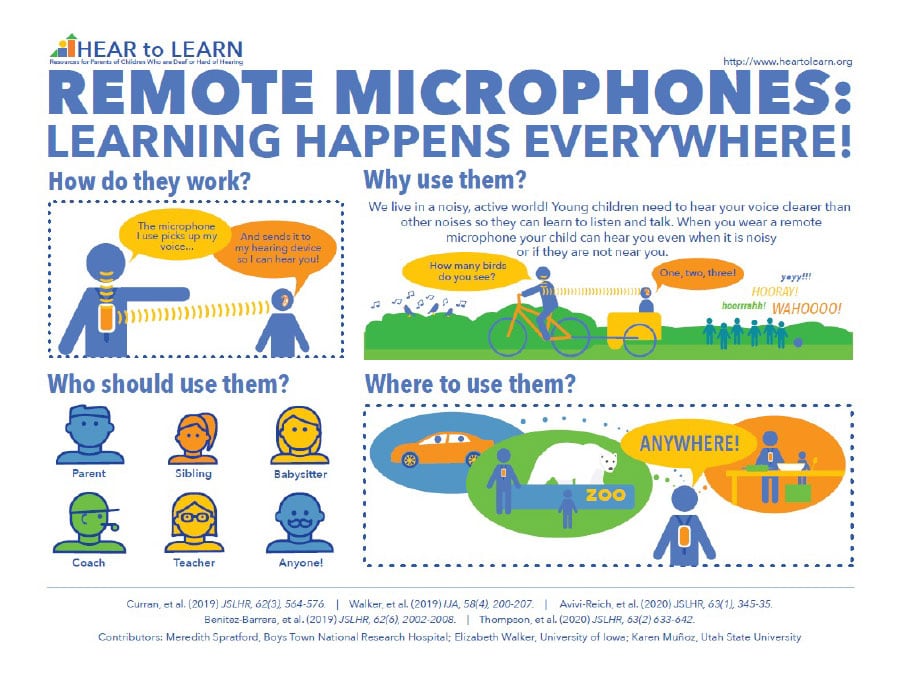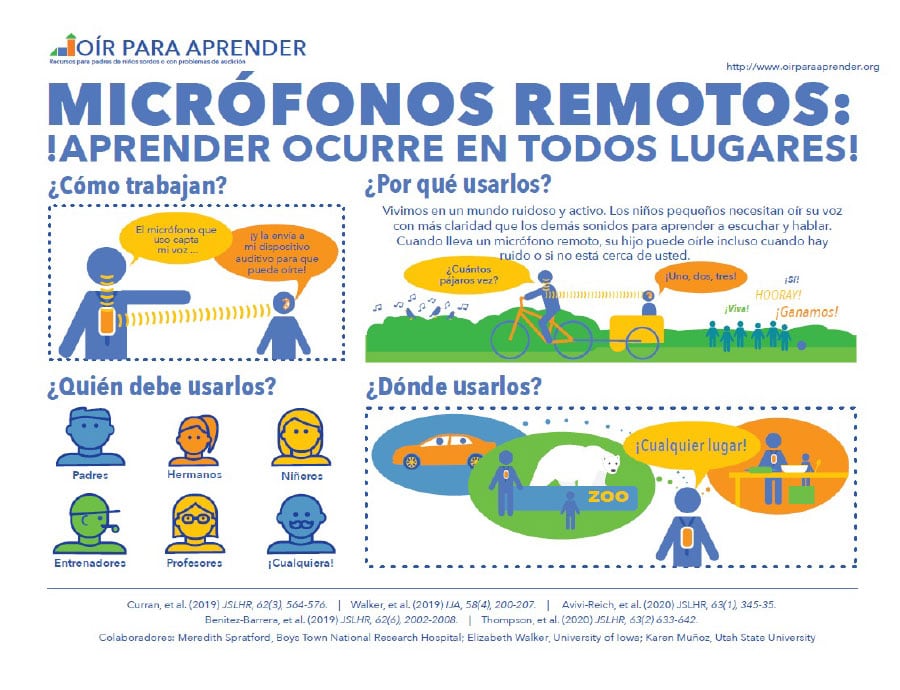Babies and young children listen in difficult situations every day-–in the car, at day care, and playing outside or at the park. Background noise, distance, reverberation, and echoes can all make listening harder. Hearing aids alone do not make listening easier in all situations. Remote microphone (RM) systems are used to help overcome the challenges of active children listening in noisy places. Listening to the remote microphone is like listening to someone talking from only a few inches away, even if that person is across the room.
Where Should RM Systems Be Used?
In the past, RM systems were only used in schools to help students listen in noisy and reverberant classrooms. Now, research supports the recommendation that pediatric audiologists fit RM systems for use at home to support listening and language learning from an early age.
Many families say that using an RM system at home gives them more opportunities to interact with their child in daily activities.
Imagine a parent and child at home in the kitchen – while the parent is working at the stove or sink their back is turned to the child. However, if the child uses an RM system he or she can easily hear what the parent is saying, no matter the direction they are facing.
Additionally,
RM systems keep the listening distance close no matter what the child is doing. When babies start to crawl and walk, the listening distance between the child and his or her parent can change quickly. Children report that using the RM system gives them a feeling of security when they are at a distance from their parents, such as in the grocery store or on a family outing. This may help children develop self-esteem and independence.
The following infographic shows activities where RM systems work well--traveling in the car or van, visiting the zoo, playing in the park, and cooking together in the kitchen. Note that your child will benefit from other people--like a coach, babysitter, dance or music teacher--using the microphone as well as family members.


Parts of a Remote Microphone System
Digital wireless technology (similar to Bluetooth) allows hearing devices to connect to small, remote microphone systems.
A remote microphone system has three parts: 1) a microphone that you wear or hold close to your mouth that picks up your voice, 2) a transmitter that sends the message from the microphone to your child’s hearing device, and 3) a receiver that picks up the message from your microphone. Most remote microphone systems used at home contain the microphone and transmitter in one small device. The receiver is typically built into the body of the child’s hearing device, but older devices may require an additional receiver component that attaches to the battery door of the hearing device.
Microphone/Transmitter
Typically a parent or caregiver will wear the microphone/transmitter around their neck on a lanyard or clipped onto their shirt. It is important to remember to wear the device about 6 inches away from the mouth to pick up the best signal. Because the microphone is placed close to your mouth, it helps your child clearly hear more of what you say when you are in a noisy place or when you are talking to them from a distance. The RM transmitter sends the signal from the microphone to the hearing device via Bluetooth or other proprietary wireless signal. The hearing device needs to be within ~50 feet of the transmitter to pick up the signal. The transmitter is typically housed in the same device as the microphone.
Remote microphone systems may include different types of external microphones or change the function of the microphone depending on its position.
- Lapel microphone: worn at chest level and placed about 6 inches away from the mouth.
- Boom microphone: a mouth-level microphone placed about 3 inches away from the mouth.
- Conference/Directional microphone: depending on the position of the microphone, it can either pick up more than one person talking (for example, multiple people sitting around a table) or focus on just one person’s voice.
Receivers
The RM receiver gets the signal sent by the transmitter and sends it to a child’s personal hearing device.
- Most current hearing devices have RM receivers built into them.
- Some RM receivers work without a hearing device and others must be connected to a person's hearing device.
Using RM Systems
Research shows that overhearing conversations helps children learn new words and improves their understanding of how to use language. Children with hearing loss may miss opportunities to overhear if people are talking more than 1 meter away or if it is noisy. Using the RM with a hearing device can give a child more opportunities to overhear some conversations, which may lead to vocabulary growth.
But, keep in mind that your child does not need to hear
everything you say or do during the day. Think about using the remote microphone when you are having a conversation or singing with your child when you are far away from them, when they can’t see your mouth, or when they are in a noisy place.
The RM microphone should be turned on when the parent is talking to the child in a noisy situation. It also should be turned on when the parent is going to be at a distance from the child, but wants the child to hear her voice at a stable level. Be cautious about wearing jewelry or articles of clothing that would make noise near the microphone of the remote microphone.
When using the remote microphone, the hearing device microphones usually stay on so that the child can hear other sounds and voices around them. This helps the child stay safe in their environment and be aware of what is happening around them.
Cost of an RM System
Buying a RM system for home use is an additional expense beyond personal hearing devices. Remote microphones for home use sometimes are included in the purchase price of hearing devices, but may cost a couple to a few hundred dollars. A RM system for educational settings may cost a few thousand dollars. While remote microphones for personal use are less expensive than remote microphone systems for educational settings, they also contain fewer advanced features than those for use in educational settings. If extra warranties or special microphones or receivers are needed, the cost may be higher. Insurance policies often do not cover RM systems. Parents often look for financial help to buy an RM system. Your family should work with your child’s audiologist to see if funding is available.
Using RM Systems in the Classroom
A typical classroom has distracting background noises such as talking, paper rustling, shuffling feet, air-handling systems, and audio-visual equipment. Most teachers move around the classroom or turn away from students when writing on a white board, causing the loudness of their voice to vary.
RM amplification systems will transmit the teacher's voice directly to the student’s hearing devices, ensuring that instruction is heard above the background noise regardless of direction or distance from the student. Learn more about
using assistive devices in the classroom.
There is a large variety of RM systems and options available for the classroom. Parents, the student, school personnel, and the student's audiologist should work together to choose a system that will provide the most benefit and flexibility in the student's environment.
For further information on RM products:
- Personal RM products for use at home:
- RM products for use at school: